
Research Projects – Rays and Small Sharks

Rays and Small Sharks
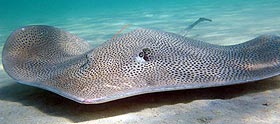
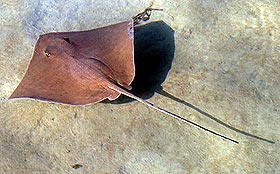
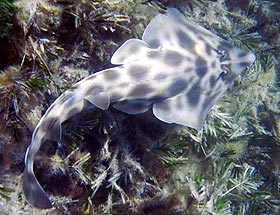
seagrass banks and are smaller than their close relatives
that prefer to spend time over sand.
Rays are a diverse group of elasmobranch fishes (sharks, skates, and rays) that are close relatives of sharks. Many species of ray feed by blowing jets of water from their mouths and flapping their wings (click here for videos). This disturbance to the bottom may be important for nutrient cycling and structuring invertebrate communities in sandy habitats. Like sharks, rays tend have long lives (sometimes decades) and reproduce slowly (several young each year). This makes them extremely vulnerable to overfishing - and in some areas they are disappearing. In other areas, however, rays are increasing as their predators (large sharks) disappear and their expanding populations are reducing populations of their prey (bivalves). Therefore, it is important to know how rays select habitats and how they might influence the communities in relatively undisturbed ecosystems like Shark Bay.
Shark Bay is home to about twenty species of rays including stingrays, guitarfish, eagle rays, and manta rays (see the ray species fact sheet for more). Many of these species are found together on the same sandflats. However, little is known about their diets, habitat use, seasonal patterns of abundance, movements, and partitioning of food resources and habitats. Rays in Shark Bay vary greatly in size from stingrays smaller than a dinner plate to shovelnose rays over 3m (10') long. Most ray species are eaten by tiger sharks and/or hammerhead sharks. Sometimes, large hammerhead sharks are seen chasing after large rays in very shallow water.
SBERP has been studying various aspects or ray behavior and ecology since 2000. Initial studies investigated the function of social resting behavior of rays. Recently, we have been conducting studies to:
- Determine the species present, their diets, and patterns of resource partitioning
- Quantify habitat use and movements relative to variation in water temperature, food availability and the abundance of possible predators (tiger and hammerhead sharks)
- Determine impacts of ray foraging on invertebrate communities
Methods for Studying Rays in Shark Bay
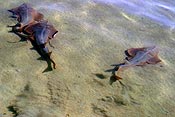
on a transect
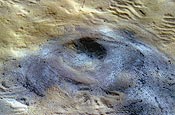
stimulate benthic communities by
bringing nutrient-rich sediment
(dark sand) to the surface
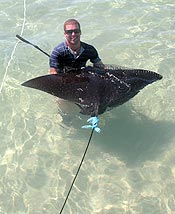
strike net
We have had to use several different methods to study the habitat use, movements, and diets of the rays in Shark Bay. Because our studies occur in shallow clear waters, we can use visual surveys that are impossible in other areas. We use these transect surveys, where we drive along set lines in various habitats to 1) determine the species composition of the ray communities over sandflats and shallow seagrass habitats 2) assess seasonal changes in ray abundance and community composition, 3) investigate spatial variation in ray feeding activity, 4) determine ray group sizes, and 5) investigate the influences of water temperature, food availability, and predation risk on habitat use by rays.
We have multiple transects in different habitats of the nearshore shallows including right next to shore, sandflats further offshore, patchy sand and seagrass habitats, and seagrass habitats. Our transects are 1500 m long and only 10m wide so we cand be sure that we see every ray - even those buried under the sand! Because we get many days where visibility is perfect we can easily make accurate counts of rays resting on the bottom within this narrow strip. We drive along the transect slowly (<5km/hr) so we don't disturb the rays. We identify every shark and ray that we see and record its behavior (feeding, resting, traveling) and location along the transect. We also record every feeding pit that we see. These pits are easy to distinguish from resting pits because they are smaller (not the entire outline of the animal) and much deeper. From 2006-2008 we conducted almost 400 transect passes.
For diet and tracking studies we need to capture rays. Shovelnose rays can be captured on longlines with baited hooks. Other rays are not easily caught on longlines in Shark Bay so we have used net captures. On low tides, we can wade in the shallows and scoop rays up in a big net, but for rays in deeper waters we have to circle them with a large net deployed from our boat. Click here to see a video of our net capture technique. Rays are brought onboard, measured, and tagged. Before being released, their stomachs are gently flushed with water to recover stomach contents so we can determine the diets of each species. We also collect small tissue samples from the tips of their fins that can be used for stable isotopic studies that help us understand long-term patterns of foraging by the rays
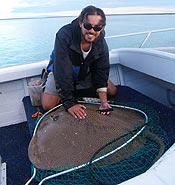
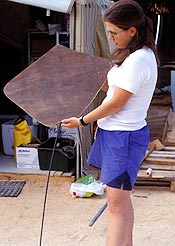
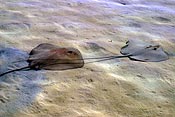
individuals?
We used several types of tracking to determine how individual rays use the sand flats and nearshore seagrass beds and their seasonal occurrence in the study area. From 2006-2007, we attached small acoustic transmitters (VEMCO V-16) to the four species of rays using a dart tag. The transmitters have a lifetime of more than two years. Each transmitter sends out a unique ping code so we know which individual we are tracking no matter when we run into the animal. The rays were monitored with an array of listening stations (VEMCO VR2s) positioned throughout the study area. Each station recorded the time, date and identity of every transmitter that passed within range (about 500-1000m). This means that we were able to monitor when each ray was in the study area and where it was on the sandflat (e.g. near the shore or close to deep waters over seagrass). Movement data are being combined with data on invertebrate distributions and predator movements to determine the factors influencing movements of rays.
We have conducted two experiments with rays to determine how their behavior is influenced by predators. First, we made experimental approaches with cutouts of potential predators toward ray groups of various sizes to determine the distance at which rays would react to the approach. Second, we placed ray decoys with tails of various lengths (normal, shortened, elongated) on sand flats to determine whether rays looking to settle sought out individuals with longer tails that might be able to detect predators at a greater distance.
Results From Ray Studies
During our studies of Shark Bay's nearshore sandflat community we have encountered 11 species of rays, ranging in size from guitarfish and shovelnose rays in excess of 2m long to maskrays that could easily fit on a dinner plate. Specimens and pictures of one of these maskrays were used to describe it as a species new to science! The observed species can be found on the sandflats year-round (except for guitarfish that have only been obervered during the warm season), although the number of rays on the flats is higher in the warm season than during the cold season. Acoustic monitoring of tagged rays and transects revealed that most species, like shovelnose rays and reticulate whiprays, spend the day resting in shallow waters very close to shore, especially during the warm season. This behavior is likely a way avoiding predation from tiger and great hammerhead sharks that are common in the study area during the warm season.

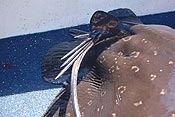
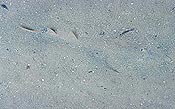
sand
Resting in the shallows, however, does not appear to be the only way rays can prevent becoming a large shark's next meal. Studies of cowtail rays found that rays were more likely to form groups when water visibility was low. This probably occurs because predator detection is more difficult when visibility is low and rays benefit rom increased detection ability in groups. This hypothesis is supported by the finding that rays prefer to rest with other rays that have long tails, even if they are not the same species of ray. Rays generally do not form groups when visibility is good, which likely can be attributed to relatively good visual detection of predators and escape costs of being in a group. Rays in groups collide with one another as they flee, making groups costly unless there are large detection benefits.
In addition to studies of ray habitat use and antipredator behavior, we have investigated the foraging habits of Shark Bay's most common rays. Most rays are relatively solitary when they are foraging, but some large groups of Himantura fai can be observed foraging on seagrass banks. Results from stable isotopic and stomach contents analyses suggest that there is a high degree of overlap in the diets of the common rays found on the sandflats. Crustaceans (like shrimp and crabs) make up the bulk of the diets for many species of rays. Cowtail rays may have a slightly different diet, consuming sandflat-associated worms and sea cucumbers rather than the seagrass-associated crustaceans.
Ray Studies Publications
- Vaudo, J. J. and M. R. Heithaus. 2012. Seasonal and diel variation in the use of nearshore sandflats by five species of rays in a near pristine ecosystem. Marine and Freshwater Research 63:1077-1084.
- Heithaus, M. R. and J. J. Vaudo. 2012. Predator-prey interactions. Pages 505-546 In: J. C. Carrier, M. R. Heithaus, and J. A. Musick (eds). The biology of sharks and their relatives, second edition. CRC Press.
- Vaudo, J. J. and M. R. Heithaus. 2011. High trophic level consumers: elasmobranchs. Pages 203-225. In E. Wolanski and D. McLusky (eds) Tretise on estuarine and coastal science. Volume 6: Trophic relationships of coastal and estuarine ecosystems. Elsivier, Inc.
- Vaudo, J. J. and M. R. Heithaus. 2011. Dietary niche overlap in a nearshore elasmobranch mesopredator community. Marine Ecology Progress Series 425: 247-260.
- Vaudo, J. J. and M. R. Heithaus. 2009. Spatiotemporal variability in a sandflat elasmobranch fauna in Shark Bay, Australia. Marine Biology 156: 2579-2590.
- Semeniuk, C.A.D. and L.M. Dill. 2005. Cost/benefit analysis of group and solitary resting in the cowtail stingray, Pastinachus sephen. Behavioral Ecology 16: 417-426.
- Semeniuk, C.A.D. and L.M. Dill. 2006. Anti-predator benefits of mixed species groups of cowtail stingrays (Pastinachus sephen) and whiprays (Himantura uranak) at rest. Ethology 112 33-43.
All photographs copyrighted; Images may be used for educational purposes. For use in other forms contact Mike Heithaus

